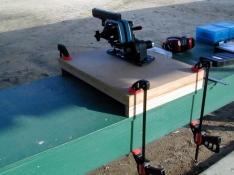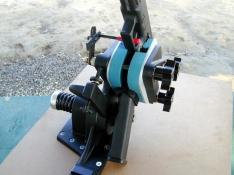| Setting Up
the Test:
Setting up for the test went surprisingly
quickly. Thanks to some pre-departure checks to make sure the inserts
were customized for the weapon, et al., I was up and shooting within
about 15 minutes of my arrival at the range. After putting the target
backer down range with a target (8.5"x11.0" white paper with a
black cross to sight on), I was able to quickly mount the weapon in the
rest and secure the rest to the bench:

With all four of those Craftsman bar
clamps cranked down tight, it would take King Kong to move that base.
One additional thing that needs to be
checked it that the 'A", "B", and "C" knobs are
not excessively tightened. On a polymer frame, "excessive" is that
point where the magazine no longer drops free from the magazine well
when you hit the release:

|
|
Shoot 'em Up!
Using a printout of the testing protocol,
I began the test at about 0900 hrs and finished right at
1200hrs on 17 November 2001. The temperature was in the high 60s
throughout the test and the wind velocity was negligible. All rounds were fired
from 25 yards.
I created a spreadsheet of the bullet
jump test data in Excel format here.
If you cannot view Excel files, or simply hate looking at spreadsheets,
I'll summarize it for you here:
Glock Stock Barrel: Avg. Group
Size = 3.122"
KKM Part # G22D1: Avg. Group Size
= 2.706"
(13.318% reduction over Glock Stock)
CAutery Proto #1: Avg. Group Size
= 2.168"
(30.570% reduction over Glock Stock)
(19.902% reduction over KKM G22D1)
Question #1 definitively answered! Decreasing
bullet jump DOES significantly improve accuracy. While the
overall improvement isn't as startling as the 51% reduction indicated by
the preliminary testing, keep in mind that this test was conducted with
all ammunition loaded at 1.140" nominal OAL vs. the 1.126" to
1.140" range in the preliminaries. In any event, 30% and 20%
performance improvements with zero additional production costs are seldom
possible. Perhaps the "industry traditionalists" will pay a
bit more attention the next time I speak with them. 
Also keep in mind that the only thing we
have changed (so far) is the barrel free-bore (lead) specification. A
host of additional specification changes are on the board for additional
accuracy enhancements.
And
then?
|
